 |
1 8 7 4 |
Musée d'Orsay |
1 9 8 6 |
 |
DEBUSSY-Reflections in the Water (1904) |
Biographies (click |
"Turner, Whistler, Monet" Exhibition
12 February 2005 - 15 May 2005
at : TATE BRITAIN, LONDON
14 October 2004 - 17 January 2005
at : GRAND PALAIS, PARIS
This exhibition was first hosted in Toronto from 06/01/2004 to 09/15/2004 at the Art Gallery of Ontario. |
English painter Joseph Mallord William Turner (1775-1851) has anticipated in his latest works the Impressionist style of painting where forms are dissolved in colored atmospheres. With such paintings as "Rain, Steam, and Speed, the Great Western Railway" - 1844, Turner manifests a sensibility to warm colors, a new informal composition and an interest for modern reality. All concerns that will later be at the heart of Impressionism. Although Turner's work is in the romantic style, whereas Impressionist painting will stick to realistic principles - the artist representing nothing but what he sees -, one may indeed see in these so extraordinarily modern paintings of Turner, a British component of Impressionism. |
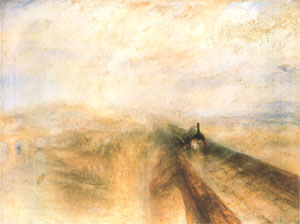 Rain, Steam, and Speed : The Great Western Railway(**) William TURNER, 1844 National Gallery, London |
Biography of ![]() Joseph Mallord William TURNER
Joseph Mallord William TURNER
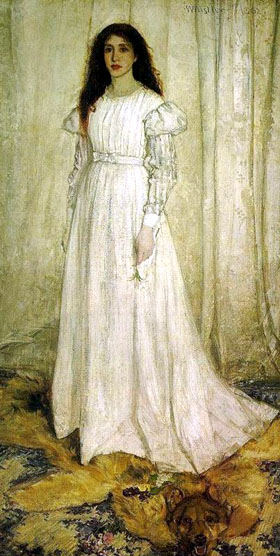 Symphony N° 1, Young Girl in White (**) James Abbott Mcneill WHISTLER, 1871 Tate Gallery, Londres |
American painter James Abbott Mc Neill Whistler (1834-1903) lived from 1855 to 1859 in Paris, where he attended the courses of the "Ecole des Beaux-Arts" ("School of Fine Arts"), studied in the Workshop of Charles Gleyre - where Monet, Renoir, Sisley and Bazille will follow him a few years later -, and became a friend of French painter Fantin-Latour and a great admirer of Edouard Manet. Because his works had been refused by the jury of the "Salon Officiel" (the French national annual Exhibition) in 1859, he moved definitely to London, where he shall become a successful painter, while frequently returning to France where he keeps on exhibiting his paintings. At the French "Salon des Refusés" ("Exhibition for the refused ones") of 1863, his painting "Symphony N° 1, Young Girl in White " - 1862, a work that had been rejected by both French Salon and British Royal Academy, will attract considerable attention. By 1870, Whistler started painting his first moonligths over the Thames River inspired by similar Turner's works, that he will call "Nocturnes" from 1872. Whereas Whistler was eccentric and exhuberant, making friendships with the most famous artists of his time, his art was at the opposite discreet and subtle. The titles of his paintings, "Harmony", "Symphony", "Arrangement", "Nocturne" intend to establish a parallel with musical works. In his point of view, a painting should not have any narrative or moral content, but be appreciated only by itself, in the same way as one listens to a musical work. |
Claude Monet (1840-1926) and James Abbott Whistler had first met in 1865 in Trouville, where they were painting together with Courbet and Daubigny .
In 1870, Monet refused to serve in the army of Napoléon III, then engaged in the Franco-Prussian war. He moved with Pissarro to London where he could admire at the National Gallery the works Turner had bequeathed to his country. As Whistler before him, he will be deeply attracted by Turner's paintings, especially those describing the fog effects over the Thames River which will inspire him three paintings ("Thames River at Westminster" - 1871) |
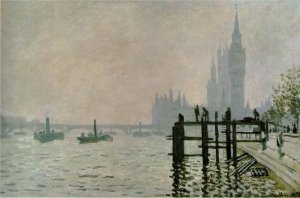 Thames River at Westminster (*) Claude MONET, 1871 National Gallery, Londres |
Monet later wrote how much he liked Turner's painting, and no doubt that his famous painting "Impression, sunrise "(1872-73)(*) that gave its name to the Impressionist Movement, a view of the Seine River in Le Havre through morning mist, is to be compared with Turner's paintings and his own works on the Thames River.
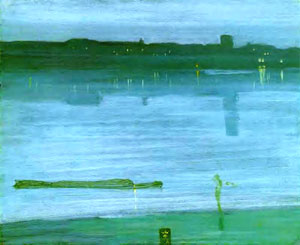 Nocturne in Blue and Silver (*) James Abbott Mc Neill WHISTLER, 1871 Oil on wood Tate Gallery, Londres |
In London, Monet probably also discovered the "Nocturnes" of Whistler, that will later be exhibited in Paris in 1873 by art dealer Durand-Ruel. Monet will form a friendship and a collaboration with Whistler that will last over time, each one of them being a representative for the other's works in his own country. Thus, Monet's paintings will be exhibited several times in London, until he will go back there for the first time in 1887, once again attracted by London and Whistler's painting . Nevertheless, it is only in 1899 that Monet will start a series of journeys in London that will end by 1901, where he shalll paint three of his most famous series, all together more than thirty paintings, on Westminster Parliament, Charing Cross Bridge and Waterloo Bridge . |
|---|
![]() THE EXHIBITION
THE EXHIBITION
This exhibition with a hundred of painted works dealing with subjects the three painters has had in common, intends to suggest Turner's influence on Monet and Whistler - even though they never met him -, and a dialog between these two friendly artists, although there seems to be much more differences than similarities in their works.
These giant artists were great travellers, and in addition to their paintings of the Thames River, they have had other themes in common, in France where they will paint numerous views of French rivers (Turner published a book of engravings "Les Rivers of France" in 1837 and Whistler "The French Set" in 1858), and Venice where Turner travelled in 1819, 1833, and 1840, Whistler in 1879-1880 and Monet in 1908.
The exhibition spreads over six rooms, the first of which being devoted to Turner's paintings, which includes the charming and colored "Chichester Canal" and other paintings of a much more modern and pre-impressionist style, the following rooms having Monet and Whistler hold a dialog in presence of many watercolors by Turner. The room next to last is entirely devoted to the remarkable series Monet made on the Thames River in London between 1899 and 1901 - dated 1904, since he worked a long time on it afterwards -. |
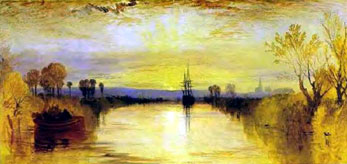 Chichester Canal (*) William TURNER, 1828 Tate Gallery, Londres |
The last room contains paintings of the three artists in Venice, as well as many beautiful watercolors by Turner.
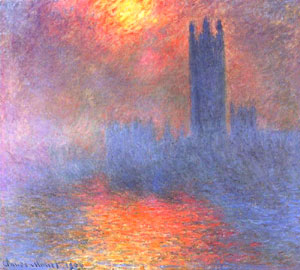 Houses of Parliament, Sun Breaking Through the Fog (*) Claude MONET, 1904 Musée d'Orsay, Paris |
The works shown in this exhibition are major masterpieces of the three artists, and it makes a visit quite worthwhile. As for the comparative purpose of the exhibition, let's quote the opinion of Jean-David Jumeau-Lafond dated 10/13/2004 in "La Tribune de l'Art" : "... For the conviction with which one leaves this exhibition is that the genius of each one of these three artists remains unique. ...Finally, is there anything in common between the delirious langage and colors of Turner, artist of the beginning of the 19th century fascinated by motion, and his desire to communicate his own feeling of atmospheres through a non realistic synthesis, the retinian look of Monet, his divided touch and his true naturalism, and lastly the still and plane visions of a contemplative and mysterious Whistler ?..." |
(*) Painting shown at the Exhibition
(**) Painting not part of the Exhibition
|
